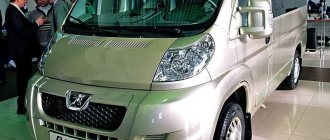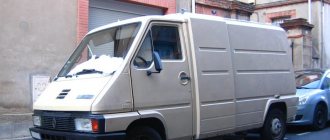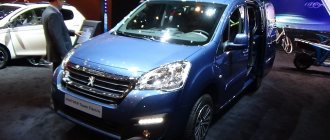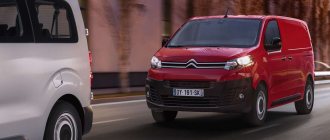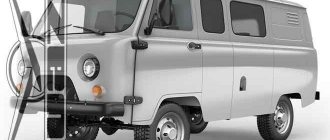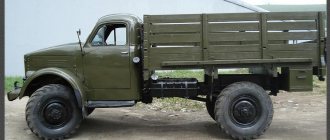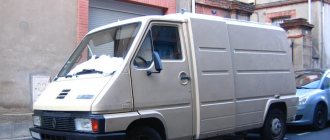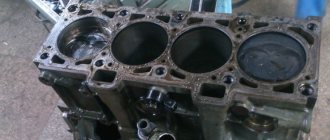The French Peugeot Boxer is a very popular commercial van model in the Russian Federation and the most dangerous competitor to the domestic GAZelle. Since the beginning of 2000, Russia has become one of 3 places where cars are produced. The reasons for the success of the car on the world market are the high comfort, excellent build quality and optimal dimensions of the Peugeot Boxer.
A little history about Peugeot
In 1976, competing companies - French automakers Citroen and Peugeot - merged into a single holding, PSA. Having entered into an agreement with the Italian Fiat, they combined capital, technology and design developments to conquer the market for commercial vehicles - light trucks for business. The three of them built one common plant to produce cars of this class. This company (“Sevel Sud” in the Italian city of Val di Sangro) has been producing light trucks with a gross weight of 2.5 to 3.5 tons and minibuses since 1981.
Peugeot J5
At the same time, each of the three automakers retains its own brand and model name. For Citroen it is Jumper , for Peugeot it is Boxer , for Fiat it is Ducato (the name of an old gold coin). The differences between these “twin brothers” are minimal, in terms of configuration, front and interior design. The third generation of “twins”, which went into production in 2006, most fully covered all niches of commercial use. In 2014, it was restyled.
“Three from the casket”: Jumper, Ducato, Boxer model 2006.
History of creation
Production of the Peugeot Boxer van began in 1994. The main base for mass production was the Italian plant Sevel. The differences of the first generation include a reinforced base on the frame, front transverse placement of the power unit, and an independent spring suspension unit with levers at the front.
All debut modifications of the car were equipped with a manual transmission with five modes. Not only Peugeot designers, but also specialists from Citroen and Fiat participated in the creation of the prototype. As a result, three types of machines of a similar series entered the market, namely:
- Peugeot Boxer.
- Citroen Jumper.
- Fiat Ducato.
The dimensions of the Peugeot Boxer and some other parameters became the dividing differences between four main modifications: a small-tonnage truck, a minibus, a classic van, and a multifunctional chassis.
The line of engines includes several engines: a two-liter gasoline version (110 “horses”), five versions of diesel analogues, the power of which ranges from 68 to 128 horsepower, with a volume of 1.9-2.8 liters.
Restyling of Peugeot Boxer 2014
The most noticeable external difference of the restyled Peugeot Boxer is the new front end. In headlights that are completely different in shape, you can now find LED running lights (although in the “base” this is an additional option). The old radiator grille has been retouched, and the bumper has changed slightly. The interior of the car has received updated basic upholstery in black fabric, with gray and orange splashes.
The car's strength and sound insulation have been improved through strengthening the body structure and innovative, more durable rear and side door mechanisms. The braking system has been improved with larger brake discs with improved performance and sound insulation. Shock absorbers of an updated design have appeared - with protection against the ingress of foreign objects.
The more modern standard multimedia system is equipped with CD, MP3, USB, AUX outputs, Bluetooth connectivity, a 5-inch touch screen and steering wheel audio controls.
Refinement of the car for sale in Russia has continued: now the standard equipment includes a metal crankcase protection, a non-programmable Webasto heating optimization system (5 kW), a 12V socket in the cargo compartment, as well as a high-capacity battery (110 Ah) and mirrors rear view with electric drive and electric heating.
In general, the modernized Peugeot Boxer has become more modern and technologically advanced, adding standard equipment (there is now ESP, a driver's airbag, and power windows), and retaining almost all of its advantages already familiar to consumers.
Restyling
In 2002, a major modernization of the Peugeot Boxer was carried out. The dimensions of the radiator grille and bumpers have become larger, and the interior has also undergone changes. In addition, the vehicle was equipped with plastic moldings along the perimeter of the body and enlarged light elements with lampshades without patterns. The rear of the body was equipped with a rounded bumper, an updated nameplate and headlights with ventilation sockets.
As for the engine, there are 2.3/2.8-liter engines, which replaced their 1.9-liter counterparts. Most other elements remain unchanged. The next update occurred four years later. This version of the Peugeot Boxer van is still relevant today. The car was developed by designers from France and Italy. They focused on improving all the major parts while updating the design, including the reformation of the interior design, safety system, design and engine compartment.
Device. Peugeot Boxer suspension and chassis
Peugeot Boxer is a car with a monocoque body, a transverse engine, a MacPherson-type front suspension and a rack and pinion steering mechanism - i.e., a standard set of technical solutions that have been tested in millions of passenger cars. But the design of the rear suspension uses small-leaf springs, already familiar to commercial trucks, which rest on the transverse beam of the non-driving axle with a square section. On short-wheelbase versions there is one sheet, on medium-wheelbase versions there is one sheet plus a spring, on long-wheelbase versions there are two sheets.
The design of the all-metal van has been specially designed to prevent dust, dirt and moisture from accumulating in hard-to-reach places. Almost 2/3 of the construction material is galvanized steel. All external surfaces are double galvanized and coated with a five-layer anti-corrosion protective compound. The Peugeot Boxer van's upholstery material uses steel sheets up to 1.8 mm thick.
The front suspension of the car is perfectly adjusted. In combination with power steering, it guarantees consistently high maneuverability and ease of control. The basic Boxer configuration includes ABS - an anti-lock braking system, and the car can be equipped with an ASR slip control system, parking sensors, an overtaking sensor, a rear view camera, ultrasonic detectors, etc.
In Europe, the Peugeot Boxer suspension can be spring or air. In Russia, pneumatic is not even offered as an option, since it is “uncomfortable to work” at extremely low frosty temperatures. The Peugeot Boxer has ventilated disc brakes at the front and disc brakes at the rear.
Peugeot Boxer engine
In the 90s/early 2000s, Peugeot Boxer cars were equipped with 2-liter petrol engines producing 109 hp, then they were replaced by P22DTE . These are four-cylinder 16-valve diesel engines equipped with turbocharging, intercooler and Common Rail electronic injection system. Working volume – 2,198 cm3. Cylinder diameter – 86 mm, piston stroke – 94.6 m. Power – 130 hp. (or 96 kW), at 3500 rpm. The maximum torque is 320 N.m, at 2000 rpm.
The engine cylinder block is made of cast iron; The cylinder block cover is made of durable light alloy AS7. The timing drive is equipped with a double-row roller chain.
Peugeot Boxer engine
According to owners' reviews, the 2.2-liter 130-horsepower diesel engine, of course, does not give the car an assertive character, but the capabilities of this power unit are still sufficient to handle competently in city traffic and to overtake fairly quickly on the highway. The driver can complain about some lack of traction only when the car is very heavily loaded. Based on the results of the test trip, diesel fuel consumption turned out to be quite acceptable - approximately 11 l/100 km.
Peugeot Boxer transmission
The engine is mated to a six-speed manual gearbox “MLGU6”. The gear shift lever is located on the tide of the center console, directly under the right hand. Its strokes are short and the switching is clear, which is not the case with all trucks. The transmission gear ratios are well chosen: the “step” between first and second gears is not too large, and when shifting up, the engine does not fall into the turbo hole. This helps in traffic jams. At the same time, sixth gear always remains working: the engine in it, even with a full load, does not go out on climbs, requiring a downshift, but pulls calmly.
Isothermal van on Peugeot Boxer chassis
The first gear is very short, it is needed only for starting from a standstill. Then the second one immediately “asks”, which, apparently, is designed to fully load the car. Theoretically, without a load, you can immediately use second gear, and first gear is only needed when loaded
Modifications and decoding of symbols
Chasis (chassis with welded cab); Fourgon (all-metal cargo van); Combi (all-metal cargo-passenger van), passenger minibus.
The decoding of the alphanumeric designations of machine modifications is as follows:
- Body type: ChC – chassis + cab; FT – all-metal van.
- Gross weight: 330 – 3 t; 333 – 3.3 t; 335 – 3.5 t; 440 – 4 t.
- Cargo compartment length: L1 – 2,670 m (standard); L2 – 3.12 m (average); L3 – 3.705 m (long); L4 – 4.07 m (extra long).
- Maximum cargo (roof) height: H1 – 1.662 m (standard); H2 – 1.932 m (average); H3 – 2.172 m (high).
- 2 HDI 130 – means “diesel engine with a volume of 2.2 liters and a power of 130 hp.”
On add-ons, Peugeot-Citroen Rus mainly cooperates with Ryazan. Also certified are Mytishchi Instrument-Making Plant in Nizhny Novgorod, GIRD from the city of Miass, Chelyabinsk Region, and Techpro from Obninsk. Their add-ons vary in design and price. Retail prices are indicated on the manufacturers' websites. Their product line is the same: flatbed (with or without awning), manufactured goods van and isothermal van. The design and materials, and, consequently, the cost characteristics are selected based on the buyer’s requests and his ability to pay.
Modifications
The dimensions of the Peugeot Boxer, as well as some other characteristics, are presented in several variations:
- Option with all-metal body (FT). The machine is used to transport goods, as well as as technical, special transport. In the same version, an isothermal van, radio, television studio and similar variations are produced.
- Utility diesel Peugeot Boxer. The car is used for passenger transportation. The set includes nine comfortable seats, the finishing of which is at the highest level. The seats are equipped with quick-release fasteners.
- A minibus with a variable interior configuration. In limited series: flatbed, refrigerator, tilt and furniture van.
Cabin Peugeot Boxer
The ergonomics of the cabin in the restyled Peugeot Boxer have changed very little. The quality of finish remains at a very high level (for commercial trucks). If the previous interior of the cabin was emphatically laconic and calm, then the creators of the updated one tried to recharge it with expression. The scales and colors of the toolbar are designed in a fashionable style. On the front panel, center console and doors, even more useful niches and containers for all sorts of things appeared (although it would seem that there was so much more). The more “grippy” steering wheel and manual transmission lever are made in a distinctly “passenger” manner; they can be trimmed with leather as an option.
The comfort in the driver's workplace is close to that of a passenger car, but not one hundred percent. For example, the seat is installed as close as possible to the standard steel partition between the passenger compartment and the cargo compartment. Therefore, you won’t be able to lounge on it, like on a sofa, with the back thrown far back. You will have to be content with a “direct bus” boarding. Each mirror consists of 2 elements (one of them is spherical), which reduces “dead zones” and gives a feeling of complete control in any situation. The high seating position and large glass area provide good visibility for the driver.
Features of the updated exterior and interior
The appearance of the new Peugeot Boxer van was presented to users by developers from Italy from Fiat Centro Style. The car was equipped with a massive bumper, deprived of its cubic shape, and rewarded with a massive U-shaped grille. Above the dividing part of the element there is a low glazing line and a panoramic windshield, which guarantees excellent visibility.
Vertical mirrors and impressive wheel arches are accentuated on the sides. The passenger Peugeot Boxer, in addition to the hinged doors in the front, now has an identical element on the right. The cabin in the new version seats three people. On the dashboard there is a tachometer, speedometer, other control systems and an on-board computer. The base of the element is made of high-quality soft plastic. Additionally, the car interior was equipped with various niches and compartments for small items and cup holders.
Technical parameters in numbers
- Dimensions: length – 4.963 (5.413; 5.998; 6.363) m; width – 2.05 m; height – 2.254 (2.522; 2764) m.
- Wheelbase – 3 (3.45; 4.035) m.
- Load capacity: 1-2 tons.
- Total weight – 3-4.4 tons.
- The volume of cargo transported in the van: from 8 to 17 cubic meters, depending on the modification.
- The width of the rear door opening is 1,562 m; The width of the side sliding door opening is 1.075 m.
- The width of the cargo compartment of an all-metal van: maximum – 1.87 m; between the wheel arches - 1.422 m.
- Tire size – 215/70 R15 C, or 225/70 R15 C, or 215/75 R16 C, or 225/75 R16 C
- The capacity of the standard fuel tank is 90 liters.
Peugeot Boxer reviews
Among the advantages of the car, owners note its reliability, maneuverability, agility, and overall good adaptability to Russian realities. I like the location of the battery: in the cabin under the floor, where it freezes less in cold weather. It is convenient to load Euro pallets into the side door: the width is specially designed and the floor is absolutely flat.
Driving the car is no more difficult than a regular SUV. The only problem is the dimensions, especially the long and extra-long versions. The length of six meters forces you to take turns almost like on a heavy-duty truck, along a large radius, so as not to catch anything or anyone with the stern. Of course, you also have to turn the “long” steering wheel much more actively.
The Peugeot Boxer rides great on good quality asphalt. But the broken surface of a secondary road or primer works poorly, the suspension reacts harshly to large joints and potholes; vibrations are transmitted to the body; the car shudders noisily, the rear swing doors knock. Particularly problematic components of Peugeot Boxers in domestic operating conditions are steering tips, electronics and ball joints.
Nuances of the restyled version
The interior of the updated passenger Peugeot Boxer has become larger and more comfortable than its competitors. It is necessary to pay tribute to the French designers who focused on ergonomic parameters. The interior equipment of the vehicle is made of modern high-quality materials, which, coupled with a powerful engine and innovative equipment, has become one of the main advantages of the van.
The modification in question has disadvantages. The main thing is to adapt the car to the domestic climate, roads and quality of technical service. Most often, problems arise with steering ends, ball joints and the electronic unit. In winter, the vehicle takes a long time to warm up, but the interior remains cold.
Peugeot Boxer price
The new Peugeot Boxer is sold at dealers at prices starting from two million rubles. On the secondary market they ask for cars of this model from 300,000 to 1,200,000 rubles, depending on the year of manufacture and technical condition.
In general, despite the skeptical attitude of potential buyers towards French and Italian automakers (in comparison with German, American and Japanese), their commercial vehicles are in stable demand in our country. The point, first of all, is the relative financial affordability of both the cars themselves and the cost of their maintenance, with good reliability and simplicity. Compared to classmates from Mercedes and Volkswagen, the Peugeot/Citroën/Fiat trio looks noticeably cheaper. Consequently, the car will “get back” in business much faster and begin to generate stable profits.

